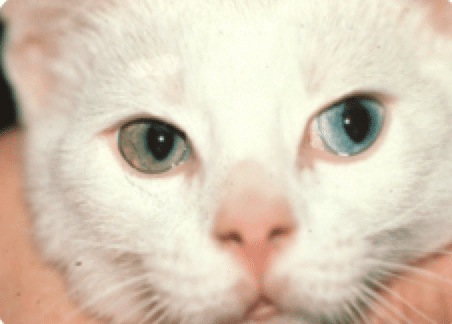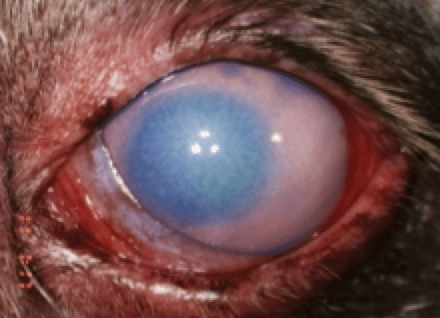What is uveitis?
The outer layer that encloses the eye is composed of the clear cornea and the white sclera. The middle layer of the eye – called the uvea – is the nutritional layer, rich in blood vessels. When inflammation develops within the uvea, this is termed uveitis. Due to its rich blood supply, the uveal tract is a natural target for diseases originating in other parts of the body. Additionally, uveitis may have causes within the eye (such as cataract), on the surface of the eye (such as a corneal ulcer) and trauma.

and even the brown pigment dispersion on the left picture.
How is uveitis diagnosed?
Uveitis is not a disease, but a condition which indicates inflammation within the eye. Signs can be as subtle as blinking, squinting, watery discharge, impaired vision and sensitivity to light, to more obvious symptoms such as red, swollen conjunctiva (pink tissue around eye), hazy or bluish cornea, reddened or discolored iris and blindness. Uveitis is diagnosed by examining the structures of the eye using instruments that magnify and illuminate. A measurement of the pressure within the eye may also be taken.
Pressure inside the eye is maintained by fluid which is continually being produced by the ciliary body. When inflammation is present, fluid production slows, resulting in below normal eye pressure. When uveitis is severe, fluid outflow is blocked, resulting in elevated eye pressure (a condition called glaucoma).


and the cloudiness of the cornea).
What are the causes of uveitis?
Many different diseases and conditions can cause uveitis. These include bacterial infection, immune-mediated or auto-immune diseases, tick borne infections, lymphoma, bleeding disorders, trauma, corneal ulcer, cataracts, as well as others. While treatment can be more specific when the actual cause of uveitis is known, it cannot be determined in up to 75% of the cases.
How is uveitis treated?
Aggressive medical treatment must be instituted to prevent permanent damage to the eye. Blood work may be recommended to rule out a systemic disease. Often the pet is put on both topical (eye drops or ointment) as well as oral anti-inflammatory medications. An oral antibiotic or anti-fungal medication may be added if the cause is suspected to be from a systemic infection. Follow up examinations ensure optimal therapy is being given and guard against possible complications. Some patients resolve with a fairly short course of therapy, while other cases are more difficult to control and may require lifelong treatment.

